Analysing Credibility of UK Social Media Influencers’ Weight-Management Blogs: A Pilot Study
Abstract
1. Introduction
2. Materials and Methods
2.1. Criteria for Standardised Credibility Checklist
2.2. Identification of Influencers
2.3. Selection of Meal Recipes
2.4. Selection of Information-Based Posts
2.5. Blog Characteristics and Influencer Demographics
2.6. General Data Protection Regulation
2.7. Adherence to Nutrition Criteria
3. Results
3.1. Influencer Demographics
3.2. Blog Characteristics
3.3. Credibility Assessment
3.3.1. Theme 1: Transparency
3.3.2. Theme 2: Use of Other Resources
3.3.3. Theme 3: Trustworthiness and Adherence to Nutritional Criteria
PHE Calorie Targets
Traffic Light Labelling
Macronutrient Analysis
3.3.4. Theme 4: Bias
3.4. Credibility Checklist Overall Pass Rate
4. Discussion
4.1. Traffic Light Labelling and Macronutrient Composition
4.2. Strengths and Limitations
5. Conclusions
Supplementary Materials
Author Contributions
Funding
Conflicts of Interest
References
- World Health Organization Obesity and Overweight: Key Facts. Available online: https://www.who.int/news-room/fact-sheets/detail/obesity-and-overweight (accessed on 24 July 2020).
- Swinburn, B.; Kraak, V.; Allender, S.; Atkins, V.; Baker, P.; Bogard, J.; Brinsden, H. The Global Syndemic of Obesity, Undernutrition, and Climate Change: The Lancet Commission report. Lancet 2019, 393, 791–846. [Google Scholar] [CrossRef]
- Dobbs, R.; Sawers, C.; Thompson, F.; Manyika, J. Overcoming Obesity: An Initial Economic Analysis; McKinsey Global Institute: New York City, NY, USA, 2014. [Google Scholar]
- Coates, A.E.; Hardman, C.A.; Halford, J.C.G.; Christiansen, P.; Boyland, E.J. Social media influencer marketing and children’s food intake: A randomized trial. Pediatrics 2019, 143. [Google Scholar] [CrossRef]
- Obesity Action Scotland Briefing: Advertising, Marketing and Obesity; Obesity Action Scotland: Glasgow, UK, 2019.
- Cambridge Dictionary Definition: Social Media. Available online: https://dictionary.cambridge.org/dictionary/english/social-media (accessed on 12 July 2020).
- We Are Social Global Digital Report 2019; We Are Social: New York City, NY, USA, 2019.
- Berryman, R.; Kavka, M. ‘I Guess A Lot of People See Me as a Big Sister or a Friend’: The role of intimacy in the celebrification of beauty vloggers. J. Gend. Stud. 2017, 26, 307–320. [Google Scholar] [CrossRef]
- Ashley, C.; Tuten, T. Creative Strategies in Social Media Marketing: An Exploratory Study of Branded Social Content and Consumer Engagement. Psychol. Mark. 2015, 32, 15–27. [Google Scholar] [CrossRef]
- Bickart, B.A.; Brunel, F.F. How Social Media Influencers Build a Brand Following by Sharing Secrets. In Strong Brands, Strong Relationships; Fournier, S., Breazeale, M., Avery, J., Eds.; Routledge: Abingdon, UK, 2015; pp. 126–152. [Google Scholar]
- Schomer, A. Influencer Marketing: State of the Social Media Influencer Market in 2020; Business Insider: New York City, NY, USA, 2019. [Google Scholar]
- Turner, P.G.; Lefevre, C.E. Instagram use is linked to increased symptoms of orthorexia nervosa. Eat. Weight Disord. 2017, 22, 277–284. [Google Scholar] [CrossRef] [PubMed]
- BEAT Eating Disorders Orthorexia. What Is Orthorexia? Available online: https://www.beateatingdisorders.org.uk/types/orthorexia?gclid=Cj0KCQjw59n8BRD2ARIsAAmgPmJz_e1glI0PH4zaf6kIUtCXxtqmxzZM9xBHrjylwgL38SWrXr2CScMaAhWxEALw_wcB (accessed on 26 October 2020).
- Boyland, E.J.; Harrold, J.A.; Dovey, T.M.; Allison, M.; Dobson, S.; Jacobs, M.C.; Halford, J.C.G. Food choice and overconsumption: Effect of a premium sports celebrity endorser. J. Pediatr. 2013, 163, 339–343. [Google Scholar] [CrossRef]
- Moukarzel, S.; Rehm, M.; Daly, A.J. Breastfeeding promotion on Twitter: A social network and content analysis approach. Matern. Child Nutr. 2020, 16, 1–8. [Google Scholar] [CrossRef]
- Astill Wright, L.; Golder, S.; Balkham, A.; Mccambridge, J. Understanding public opinion to the introduction of minimum unit pricing in Scotland: A qualitative study using Twitter. BMJ Open 2019, 9, e029690. [Google Scholar] [CrossRef]
- Hatchard, J.L.; Neto, J.Q.F.; Vasilakis, C.; Evans-Reeves, K.A. Tweeting about public health policy: Social media response to the UK Government’s announcement of a Parliamentary vote on draft standardised packaging regulations. PLoS ONE 2019, 14, e0211758. [Google Scholar] [CrossRef]
- Mete, R.; Curlewis, J.; Shield, A.; Murray, K.; Bacon, R.; Kellett, J. Reframing healthy food choices: A content analysis of Australian healthy eating blogs. BMC Public Health 2019, 19, 1–10. [Google Scholar] [CrossRef]
- Buxton, T. Effective Ways to Improve Health Education Materials. J. Health Educ. 1999, 30, 47–61. [Google Scholar] [CrossRef]
- Le, L.; Finn, A. Evaluating Credibility of Online Nutrition Information: A Content Analysis on Current Nutrition-Related Blogs. Ren. Nutr. Forum 2019, 37, 5–9. [Google Scholar] [CrossRef]
- Dumas, A.-A.; Lemieux, S.; Lapointe, A.; Dugrenier, M.; Desroches, S. A Comparative Content Analysis of Vegetarian Food Blogs Written by Registered Dietitians and Non-Registered Dietitians. Can. J. Diet. Pract. Res. 2017, 78, 86–91. [Google Scholar] [CrossRef] [PubMed]
- Chan, T.; Drake, T.; Vollmer, R.L. A qualitative research study comparing nutrition advice communicated by registered Dietitian and non-Registered Dietitian bloggers. J. Commun. Healthc. 2020, 13, 55–63. [Google Scholar] [CrossRef]
- Coates, A.; Hardman, C.; Halford, J.; Paul, C.; Boyland, E. The effect of influencer marketing of food and a “protective” advertising disclosure on children’s food intake. Pediatr. Obes. 2019, 14, e12540. [Google Scholar] [CrossRef] [PubMed]
- Hendriks, H.; Wilmsen, D.; van Dalen, W.; Gebhardt, W.A. Picture Me Drinking: Alcohol-Related Posts by Instagram Influencers Popular Among Adolescents and Young Adults. Front. Psychol. 2020, 10, 1–9. [Google Scholar] [CrossRef]
- Coates, A.E.; Hardman, C.A.; Halford, J.C.G.; Christiansen, P.; Boyland, E.J. Food and Beverage Cues Featured in YouTube Videos of Social Media Influencers Popular With Children: An Exploratory Study. Front. Psychol. 2019, 10, 1–14. [Google Scholar] [CrossRef]
- Coates, A.E.; Hardman, C.A.; Halford, J.C.G.; Christiansen, P.; Boyland, E.J. “It’s Just Addictive People That Make Addictive Videos”: Children’s Understanding of and Attitudes Towards Influencer Marketing of Food and Beverages by YouTube Video Bloggers. Int. J. Environ. Res. Public Health 2020, 17, 449. [Google Scholar] [CrossRef]
- Public Health England Plans to Cut Excess Calorie Consumption Unveiled. Available online: https://www.gov.uk/government/news/plans-to-cut-excess-calorie-consumption-unveiled#:~:text=the launch of the latest,calories in excess each day (accessed on 18 November 2020).
- Food Standards Agency (FSA) Guide to Creating a Front of Pack (Fop) Nutrition Label for Pre-Packed Products Sold Through Retail Outlets; Department of Health: London, UK, 2016.
- Paterson, Q.S.; Thoma, B.; Milne, W.K.; Lin, M.; Chan, T.M. A Systematic Review and Qualitative Analysis to Determine Quality Indicators forHealth Professions Education Blogs and Podcasts. J. Grad. Med. Educ. 2015, 7, 549–554. [Google Scholar] [CrossRef]
- Influence.co. Available online: https://influence.co/ (accessed on 26 October 2020).
- McCoy, J. How to Get Verified on Social Media: Facebook, Instagram, Twitter & More. Available online: https://www.searchenginejournal.com/social-media-account-verification-guide/353570/#close (accessed on 12 July 2020).
- National Institute for Health and Clinical Excellence (NICE) Weight Management: Lifestyle Services for Overweight or Obese Adults; NICE: London, UK, 2014.
- Su, S.; Wang, Y.; Zhang, Z.; Chang, C.; Zia, M.A. Identifying and tracking topic-level influencers in the microblog streams. Mach. Learn. 2018, 107, 551–578. [Google Scholar] [CrossRef]
- Ismail, K. Social Media Influencers: Mega, Macro, Micro or Nano. Available online: https://www.cmswire.com/digital-marketing/social-media-influencers-mega-macro-micro-or-nano/ (accessed on 12 July 2020).
- Berne-Manero, C.; Marzo-Navarro, M. Exploring how influencer and relationship marketing serve corporate sustainability. Sustainability 2020, 12, 4392. [Google Scholar] [CrossRef]
- Food Standards Agency. Food Portion Sizes, 2nd ed.; Patel, S., Mills, A., Crawley, H., Eds.; The Stationery Office: London, UK, 2005; ISBN 978-0-11-242961-6.
- Ipsos Mori The Most Trusted Profession? Available online: https://thinks.ipsos-mori.com/the-most-trusted-profession/ (accessed on 26 October 2020).
- Scottish Intercollegiate Guidelines Network (SIGN) Management of Obesity, a National Clinical Guideline; SIGN: Edinburgh, UK, 2010.
- Association for Nutrition The UK Voluntary Register of Nutritionists (UKVRN). Available online: https://www.associationfornutrition.org/ (accessed on 23 November 2020).
- European Union Complete Guide to GDPR Compliance. Available online: https://gdpr.eu/ (accessed on 26 October 2020).
- Nutritics; Libro: Dublin, UK, 2018.
- Institute of Food and Research Mccance and Widdowson’s Composition of Foods Integrated Dataset (Cofid); Public Health: London, UK, 2015.
- British Nutrition Foundation (BNF). Nutrition Requirements; BNF: London, UK, 2016. [Google Scholar]
- Jarreau, P. Science bloggers’ self-perceived communication roles. J. Sci. Commun. 2015, 14, 1–25. [Google Scholar] [CrossRef]
- Miller, E.A.; Pole, A. Diagnosis blog: Checking up on health blogs in the blogosphere. Am. J. Public Health 2010, 100, 1514–1519. [Google Scholar] [CrossRef] [PubMed]
- Vuelio UK Influencer Survey 2020; Vuelio: London, UK, 2020.
- Meng, Y.; Bai, H.; Wang, S.; Li, Z.; Wang, Q.; Chen, L. Efficacy of low carbohydrate diet for type 2 diabetes mellitus management: A systematic review and meta-analysis of randomized controlled trials. Diabetes Res. Clin. Pract. 2017, 131, 124–131. [Google Scholar] [CrossRef]
- Snorgaard, O.; Poulsen, G.M.; Andersen, H.K.; Astrup, A. Systematic review and meta-analysis of dietary carbohydrate restriction in patients with type 2 diabetes. BMJ Open Diabetes Res. Care 2017, 5. [Google Scholar] [CrossRef]
- Miller, M.; Miller, S. Nutrition Monitoring Survey Series 2015 Key Findings; Government of Western Australia, Department of Health: Perth, Australia, 2017.
- Arslain, K.; Gustafson, C.R.; Baishya, P.; Rose, D.J. Determinants of gluten-free diet adoption among individuals without celiac disease or non-celiac gluten sensitivity. Appetite 2020, 156, 104958. [Google Scholar] [CrossRef]
- British Dietetic Association Survey Finds that Almost 60% of People Trust Nutrition Advice from Underqualified Professionals. Available online: https://www.bda.uk.com/resource/survey-finds-that-almost-60-of-people-trust-nutrition-advice-from-underqualified-professionals.html (accessed on 12 July 2020).
- National Institute for Health and Clinical Excellence (NICE) Obesity: Identification, Assessment and Management, Clinical Guideline [CG189]; NICE: London, UK, 2014.
- Nikolaou, C.K.; Hankey, C.R.; Lean, M.E.J. Preventing weight gain with calorie-labeling. Obesity 2014, 22, 2277–2283. [Google Scholar] [CrossRef]
- Fitch, R.C.; Harnack, L.J.; Neumark-Sztainer, D.R.; Story, M.T.; French, S.A.; Oakes, J.M.; Rydell, S.A. Providing calorie information on fast-food restaurant menu boards: Consumer views. Am. J. Health Promot. 2009, 24, 129–132. [Google Scholar] [CrossRef]
- Scarborough, P.; Matthews, A.; Eyles, H.; Kaur, A.; Hodgkins, C.; Raats, M.M.; Rayner, M. Reds are more important than greens: How UK supermarket shoppers use the different information on a traffic light nutrition label in a choice experiment. Int. J. Behav. Nutr. Phys. Act. 2015, 12, 1–9. [Google Scholar] [CrossRef]
- The European Food Information Council (EUFIC) Global Update on Nutrition Labelling; EUFIC: Brussels, Belgium, 2018.
- UK Government Building on the Success of Front-Of-Pack Nutrition Labelling in the UK: A Public Consultation. Available online: https://www.gov.uk/government/consultations/front-of-pack-nutrition-labelling-in-the-uk-building-on-success (accessed on 23 November 2020).
- Steenhuis, I.; Poelman, M. Portion Size: Latest Developments and Interventions. Curr. Obes. Rep. 2017, 6, 10–17. [Google Scholar] [CrossRef]
- Lewis, H.B.; Ahern, A.L.; Jebb, S.A. How much should I eat? A comparison of suggested portion sizes in the UK. Public Health Nutr. 2012, 15, 2110–2117. [Google Scholar] [CrossRef] [PubMed]
- Hetherington, M.M.; Blundell-Birtill, P. The portion size effect and overconsumption—Towards downsizing solutions for children and adolescents. Nutr. Bull. 2018, 43, 61–68. [Google Scholar] [CrossRef]
- Tal, A.; Niemann, S.; Wansink, B. ‘Depicted serving size: Cereal packaging pictures exaggerate serving sizes and promote overserving’. BMC Public Health 2017, 17, 1–7. [Google Scholar]
- Khehra, R.; Fairchild, R.; Morgan, M. UK children’s breakfast cereals—An oral health perspective. Nat. Publ. Gr. 2018, 225, 164–169. [Google Scholar]
- McGale, L.S.; Smits, T.; Halford, J.C.G.; Harrold, J.A.; Boyland, E.J. The influence of front-of-pack portion size images on children’s serving and intake of cereal. Pediatr. Obes. 2020, 15, 1–8. [Google Scholar] [CrossRef]
- Schneider, E.P.; McGovern, E.E.; Lynch, C.L.; Brown, L.S. Do Food Blogs Serve as a Source of Nutritionally Balanced Recipes? An Analysis of 6 Popular Food Blogs. J. Nutr. Educ. Behav. 2013, 45, 696–700. [Google Scholar] [CrossRef]
- Thomas, J.; Bond, D.; Phelan, S.; Hill, J.O.; Wing, R.R. Weight-Loss Maintenance for 10 Years in the National Weight Control Registry. Am. J. Prev. Med. 2014, 46, 17–23. [Google Scholar] [CrossRef]
- Veldhorst, M.; Smeets, A.; Soenen, S.; Hochstenbach-Waelen, A.; Hursel, R.; Diepvens, K.; Lejeune, M.; Luscombe-Marsh, N.; Westerterp-Plantenga, M. Protein-induced satiety: Effects and mechanisms of different proteins. Physiol. Behav. 2008, 94, 300–307. [Google Scholar] [CrossRef]
- Crocombe, D. UK medical student perceptions on diet and nutrition education: Results of a national survey. Gut 2018, 67, A272. [Google Scholar]
- Wetherell, S. Results of the 2013 State of Food Blogging Survey. Available online: http://www.foodista.com/blog/2013/05/29/results-of-the-2013-state-of-food-blogging-survey (accessed on 12 July 2020).
- Altman, I.; Taylor, D. Social Penetration: The Development of Interpersonal Relationships; Holt, W., Ed.; Rinehart: New York, NY, USA, 1973. [Google Scholar]
- Lepkowksa-White, E.; Kortright, E. The business of blogging: Effective approaches of women food bloggers. J. Foodserv. Bus. Res. 2018, 21, 257–279. [Google Scholar] [CrossRef]
- Wakefield, J. Social Media Stars Agree to Declare When They Post Ads. BBC News. 2019. Available online: https://www.bbc.co.uk/news/technology-46960179#:~:text=Sixteen%20social%20media%20stars%20including,loans%20of%20products%20they%20endorse (accessed on 2 July 2020).
- Medlin, S.; El-Shafie, H. Regulate Health Information On Social Media. Available online: https://www.change.org/p/matt-hancock-regulate-health-information-on-social-media?recruiter=1116677116&utm_source=share_petition&utm_medium=copylink&utm_campaign=share_petition (accessed on 13 July 2020).
- Boyland, E.J.; Harrold, J.A.; Kirkham, T.C.; Halford, J.C.G. The extent of food advertising to children on UK television in 2008. Int. J. Pediatr. Obes. 2011, 6, 455–461. [Google Scholar] [CrossRef] [PubMed]
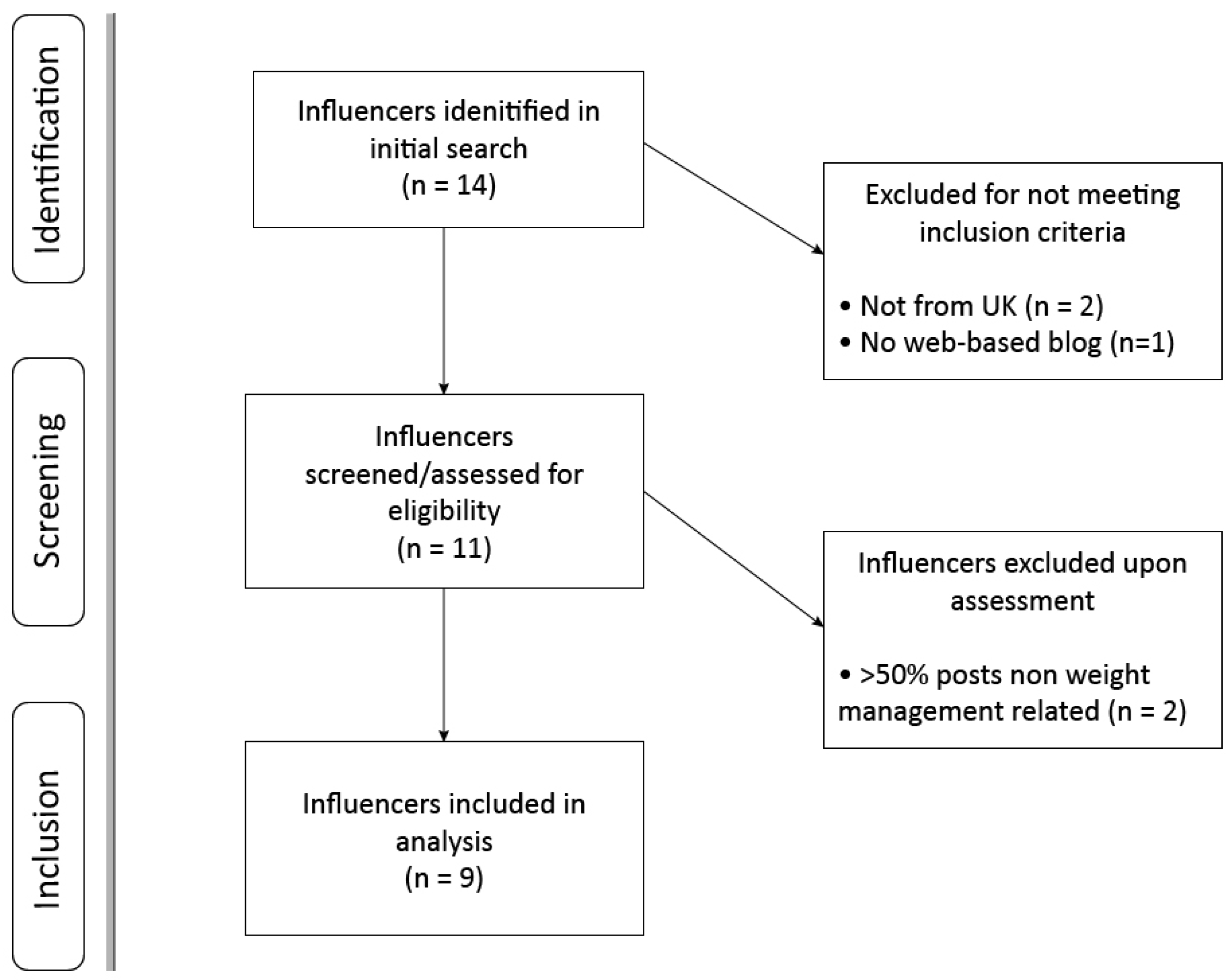
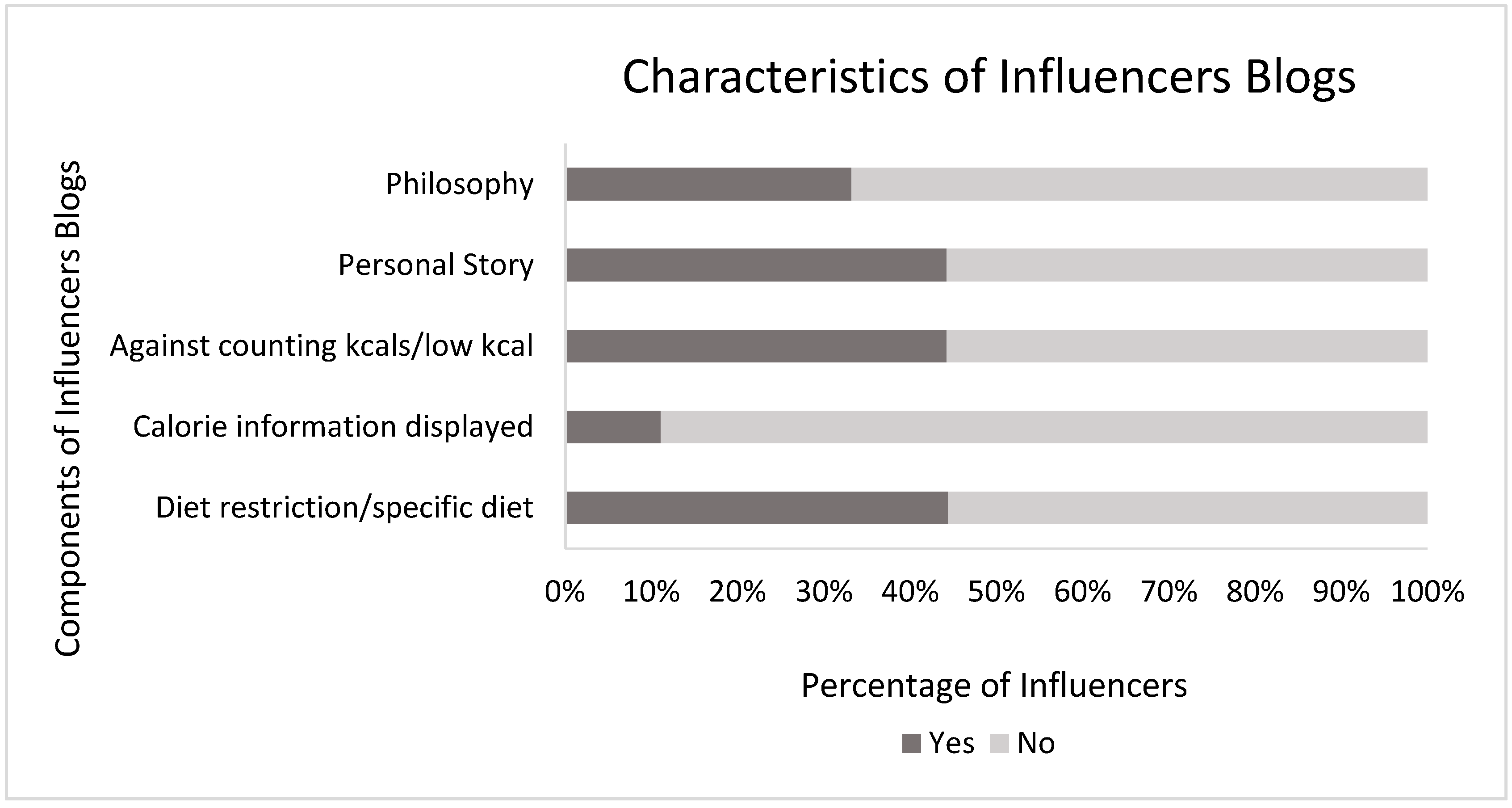
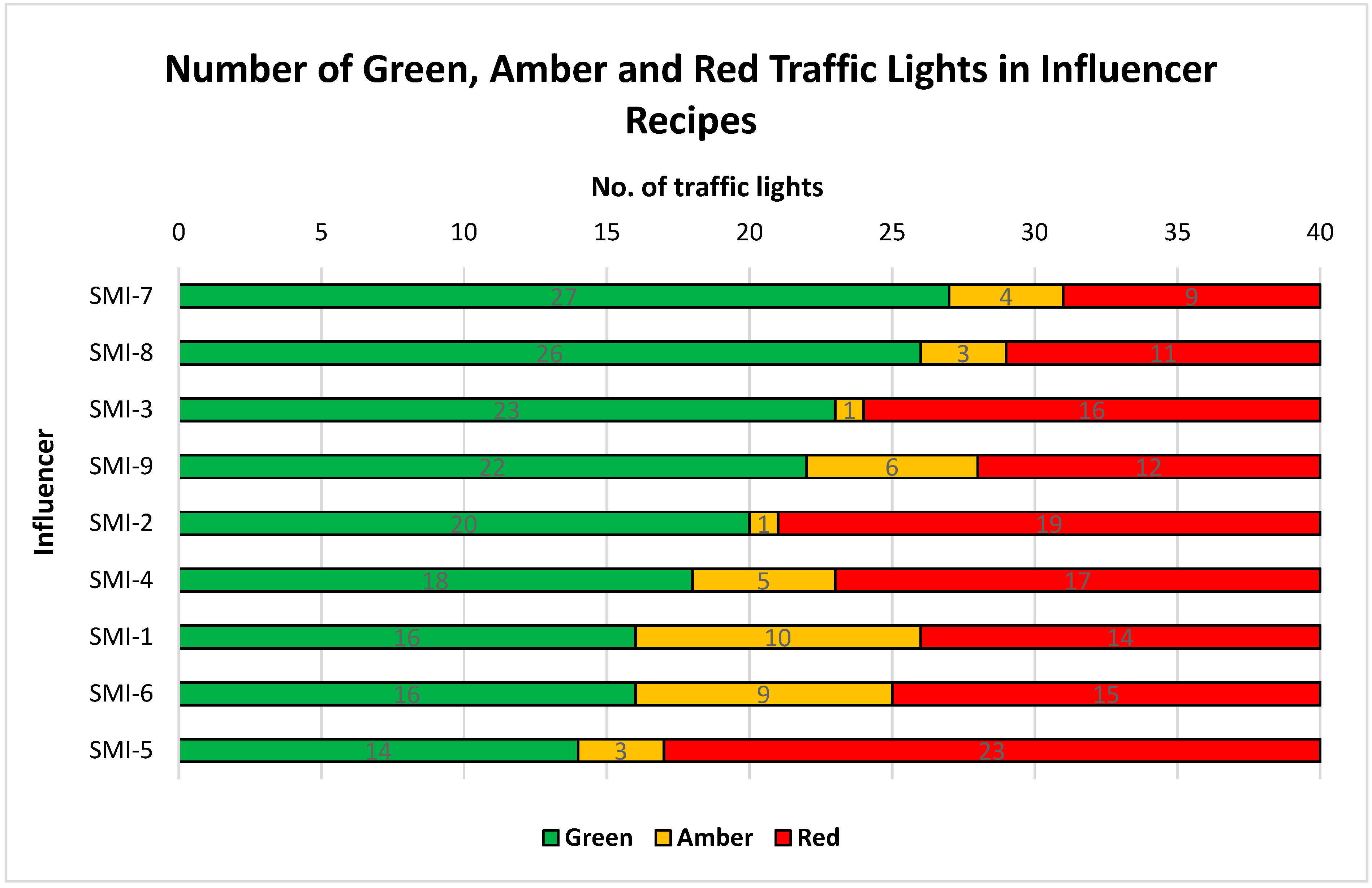
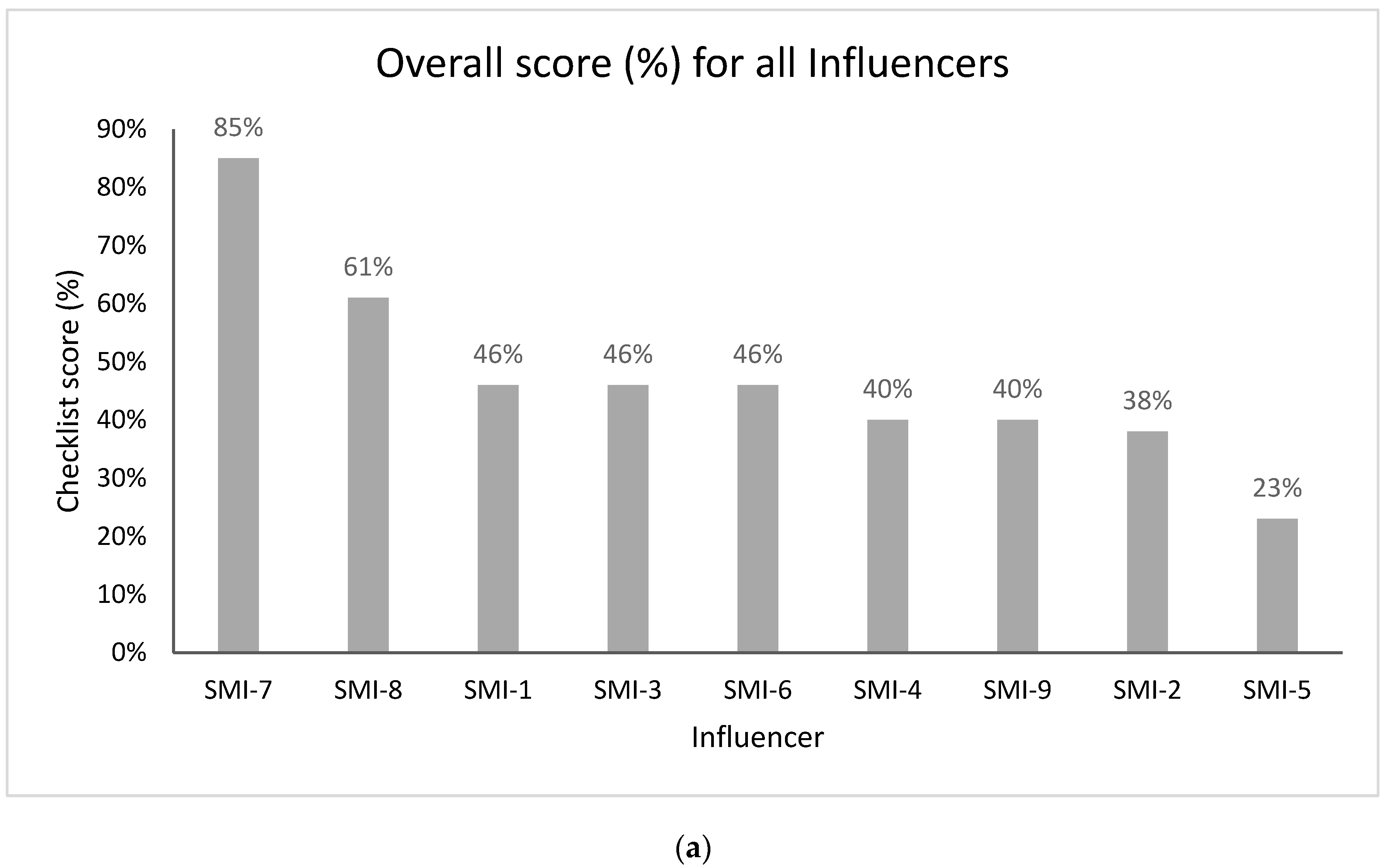
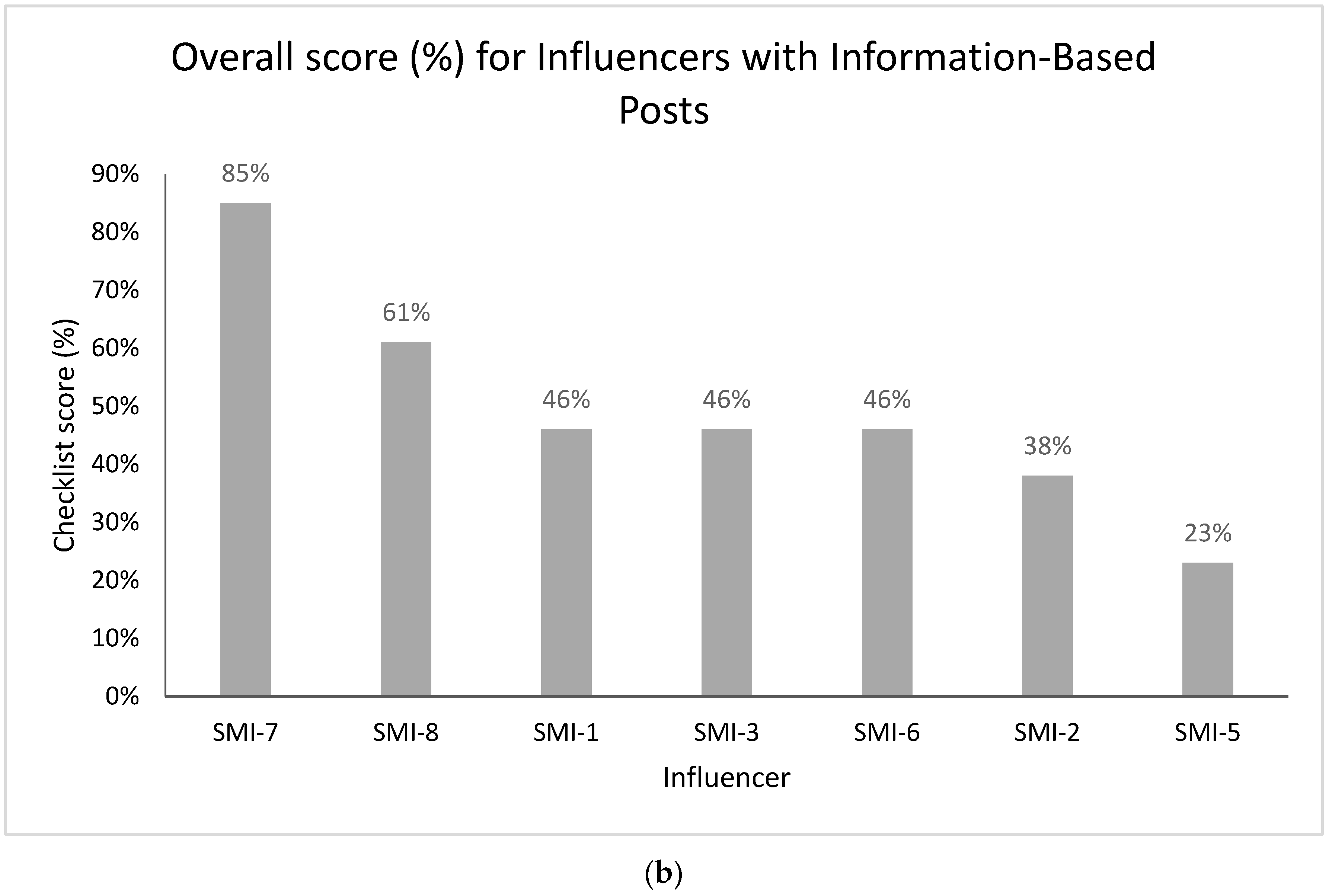
| Theme | Comments |
|---|---|
| Transparency | |
| Is the identity of the author always clear? | Either explicitly stated or implied through use of personal pronouns. |
| Is there a professional statement present? | A note of their background and experience in the field. |
| Does the influencer respect and protect the privacy of blog readers? | Is there a clearly accessible privacy statement? Normally situated in the footer and should be accessible from every page. Must be specific to the blog and protection of readers/subscribers. |
| Are appropriate disclaimers regarding the use of the blog stated clearly? | Are these clearly accessible from the blog? Normally situated in the footer and should be accessible from every page. |
| Use of Other Resources | |
| Are references cited on the blog? | Based on the first 20 information-based posts. 70% to pass. |
| Are the references always evidence-based? | Based on the first 20 information-based posts. 70% to pass. |
| Trustworthiness and Adherence to Nutritional Criteria | |
| Is the author well qualified to provide weight management information? | ‘Well qualified’ for this purpose means that they hold a relevant nutrition or dietetics degree or are a medical doctor. |
| Has the influencer been awarded any quality credentials/badges from independent organisations? | From official nutrition or dietetics organisations, not including holistic or nutritional therapy credentials. |
| Do the recipes in the blog adhere to UK nutritional criteria (PHE kcal)? Do the recipes in the blog adhere to UK nutritional criteria (FSA traffic lights)? | 70% to pass, to ensure ‘adherence’. 70% to pass, to ensure ‘adherence’ |
| Bias | |
| Does the blog clearly differentiate between advertisement and content? | Sponsored posts, including paid promotions/partnerships, Google ads, advertising of products and external services, affiliate links. |
| If the blog includes external advertising, is it disclosed? | Sponsored posts, including paid promotions/partnerships, Google ads, advertising of products and external services, affiliate links. |
| Does the influencer always make clear distinction between fact and opinion on their blog? | Linked to the citation of references. |
| Influencer | SMI-3 | SMI-4 | SMI-9 | SMI-8 |
|---|---|---|---|---|
| Diet | Gluten-Free | Gluten-free | Gluten-free | Gluten-free |
| Wheat-Free | Grain-free | Whole foods | Low grain | |
| Dairy-Free | No hydrogenated oils | No processed foods | Dairy-free | |
| Refined Sugar Free | Refined sugar free | Plant-based/vegan | Refined sugar-free | |
| Plant-based | Paleo |
| Influencer | Breakfast | Lunch | Dinner | |||
|---|---|---|---|---|---|---|
| Mean kcal | % PHE Target | Mean kcal | % PHE Target | Mean kcal | % PHE Target | |
| (Range) | (Range) | (Range) | ||||
| SMI-1 | 420 | 105 | 479 | 80 | 650 | 108 |
| (195–662) | (360–569) | (512–845) | ||||
| SMI-2 | 695 | 174 | 840 | 140 | 517 | 86 |
| (615–851) | (690–982) | (419–647) | ||||
| SMI-3 | 517 | 129 | 642 | 107 | 544 | 91 |
| (287–861) | (516–805) | (314–992) | ||||
| SMI-4 | 495 | 124 | 596 | 99 | 480 | 80 |
| (250–651) | (524–686) | (356–764) | ||||
| SMI-5 | 623 | 156 | 684 | 114 | 843 | 140 |
| (280–1062) | (424–1024) | (486–1592) | ||||
| SMI-6 | 457 | 114 | 426 | 71 | 454 | 76 |
| (293–594) | (269–640) | (234–641) | ||||
| SMI-7 | 460 | 115 | 479 | 80 | 471 | 79 |
| (387–593) | (353–623) | (312–641) | ||||
| SMI-8 | 236 | 59 | 475 | 79 | 429 | 71 |
| (130–395) | (246–915) | (263–672) | ||||
| SMI-9 | 481 | 120 | 551 | 92 | 623 | 104 |
| (232–630) | (214–987) | (374–883) | ||||
| Influencer | PHE Kcal Limit (%) | Traffic Lights (%) |
|---|---|---|
| SMI-7 | 90 | 78 |
| SMI-8 | 80 | 73 |
| SMI-6 | 80 | 63 |
| SMI-1 | 70 | 65 |
| SMI-3 | 70 | 60 |
| SMI-4 | 60 | 58 |
| SMI-9 | 50 | 70 |
| SMI-5 | 50 | 43 |
| SMI-2 | 40 | 53 |
| Influencer | Mean Macronutrient Composition (% and Range) | ||
|---|---|---|---|
| Carbohydrate | Protein | Fat | |
| SMI-1 | 33 (7.7–56.5) | 26 (12.2–46.7) | 40 (23.9–56.5) |
| SMI-2 | 35 (11.4–47.8) | 35 (21.1–52.2) | 30 (14.4–49.4) |
| SMI-3 | 48 (14.7–69.5) | 13 (6.3–19.3) | 39 (12.9–67.5) |
| SMI-4 | 15 (2.8–27.8) | 25 (4.8–26.5) | 60 (33.9–81.5) |
| SMI-5 | 33 (10.5–77.9) | 19 (4.8–32) | 48 (11–70.2) |
| SMI-6 | 43 (9.7–75.3) | 19 (7.8–44) | 37 (11.3–61.5) |
| SMI-7 | 24 (3.5–57.2) | 30 (19–41.1) | 45 (9–70.2) |
| SMI-8 | 18 (3.8–36.5) | 29 (13.9–40.9) | 53 (26.5–73.1) |
| SMI-9 | 47 (21.4–72.2) | 12 (7.9–17.6) | 41 (11–64.2) |
Publisher’s Note: MDPI stays neutral with regard to jurisdictional claims in published maps and institutional affiliations. |
© 2020 by the authors. Licensee MDPI, Basel, Switzerland. This article is an open access article distributed under the terms and conditions of the Creative Commons Attribution (CC BY) license (http://creativecommons.org/licenses/by/4.0/).
Share and Cite
Sabbagh, C.; Boyland, E.; Hankey, C.; Parrett, A. Analysing Credibility of UK Social Media Influencers’ Weight-Management Blogs: A Pilot Study. Int. J. Environ. Res. Public Health 2020, 17, 9022. https://doi.org/10.3390/ijerph17239022
Sabbagh C, Boyland E, Hankey C, Parrett A. Analysing Credibility of UK Social Media Influencers’ Weight-Management Blogs: A Pilot Study. International Journal of Environmental Research and Public Health. 2020; 17(23):9022. https://doi.org/10.3390/ijerph17239022
Chicago/Turabian StyleSabbagh, Christina, Emma Boyland, Catherine Hankey, and Alison Parrett. 2020. "Analysing Credibility of UK Social Media Influencers’ Weight-Management Blogs: A Pilot Study" International Journal of Environmental Research and Public Health 17, no. 23: 9022. https://doi.org/10.3390/ijerph17239022
APA StyleSabbagh, C., Boyland, E., Hankey, C., & Parrett, A. (2020). Analysing Credibility of UK Social Media Influencers’ Weight-Management Blogs: A Pilot Study. International Journal of Environmental Research and Public Health, 17(23), 9022. https://doi.org/10.3390/ijerph17239022






